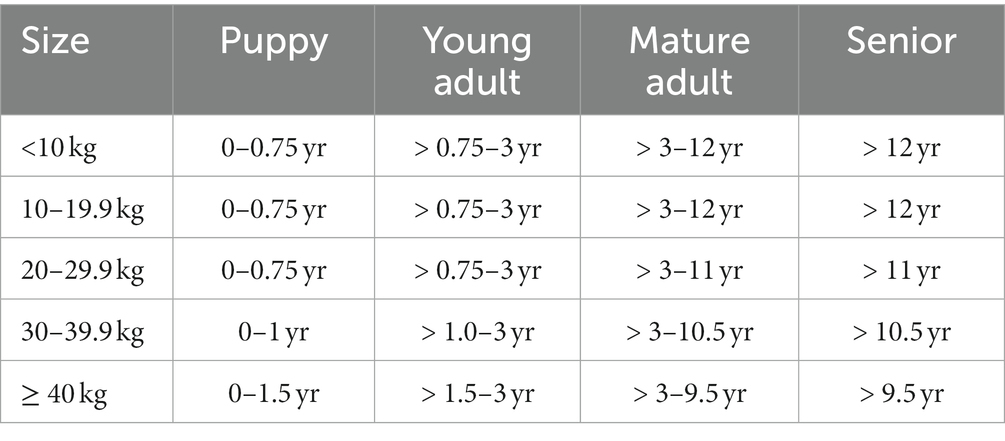Lifetime prevalence of owner-reported medical conditions in the 25 most common dog breeds in the Dog Aging Project pack
- 1Department of Veterinary Clinical Sciences, College of Veterinary Medicine, Purdue University, West Lafayette, IN, United States
- 2School of Life Sciences, Arizona State University, Tempe, AZ, United States
- 3Department of Small Animal Clinical Sciences, College of Veterinary Medicine, University of Tennessee, Knoxville, TN, United States
- 4Department of Laboratory Medicine and Pathology, University of Washington School of Medicine, Seattle, WA, United States
- 5Department of Biology, University of Washington, Seattle, WA, United States
- 6Center for Evolution and Medicine, Arizona State University, Tempe, AZ, United States
- 7School for Human Evolution and Social Change, Arizona State University, Tempe, AZ, United States
- 8Department of Small Animal Clinical Sciences, College of Veterinary Medicine & Biomedical Sciences, Texas A&M University, College Station, TX, United States
Introduction: Large scale data on the prevalence of diverse medical conditions among dog breeds in the United States are sparse. This cross-sectional study sought to estimate the lifetime prevalence of medical conditions among US dogs and to determine whether purebred dogs have higher lifetime prevalence of specific medical conditions compared to mixed-breed dogs.
Methods: Using owner-reported survey data collected through the Dog Aging Project (DAP) Health and Life Experience Survey for 27,541 companion dogs, we identified the 10 most commonly reported medical conditions in each of the 25 most common dog breeds within the DAP cohort. Lifetime prevalence estimates of these medical conditions were compared between mixed-breed and purebred populations. The frequency of dogs for whom no medical conditions were reported was also assessed within each breed and the overall mixed-breed and purebred populations.
Results: A total of 53 medical conditions comprised the top 10 conditions for the 25 most popular breeds. The number of dogs for whom no medical conditions were reported was significantly different (p = 0.002) between purebred (22.3%) and mixed-breed dogs (20.7%). The medical conditions most frequently reported within the top 10 conditions across breeds were dental calculus (in 24 out of 25 breeds), dog bite (23/25), extracted teeth (21/25), osteoarthritis (15/25), and Giardia (15/25).
Discussion: Purebred dogs in the DAP did not show higher lifetime prevalence of medical conditions compared to mixed-breed dogs, and a higher proportion of purebred dogs than mixed-breed dogs had no owner-reported medical conditions. Individual breeds may still show higher lifetime prevalence for specific conditions.
1. Introduction
The domestic dog (Canis familiaris) is a highly morphologically diverse species including various breeds developed over the past few hundred years resulting in dramatic phenotypic variations (20, 64). Humans have selected for specific phenotypic traits leading to the development of many pedigree dog breeds. There are currently 197 registered breeds with the American Kennel Club (AKC) and approximately 400 breeds recognized internationally (1). Inbreeding or line-breeding has been deployed in the development of most dog breeds, raising the concern that purebred dogs will have a greater chance of carrying genetic disorders (1, 12, 20). Inbreeding can lead to an increased prevalence of recessive genetic disorders, making what would normally be a rare disease more common within that breed or familial line (12, 20, 58); however, it can also lead to purging of the genetic load and associated elimination of inbreeding depression (10, 65). It is a common belief that purebred dogs are at a greater risk for disease compared to mixed-breed dogs, often due to concerns for genetic or inherited disorders; however, research has shown that this is not always the case. Some studies suggest specific breeds or groups of breeds are at greater risk for certain disorders, but simply being purebred may not necessarily be associated with increased disorder prevalence overall (43, 55).
The majority of studies evaluating breed predilections focus on either the breeds affected by a certain medical condition or the medical conditions most prevalent in a specific breed (32, 33, 37–39, 41, 42, 48, 60). For example, dilated cardiomyopathy has been determined to be far more common in Doberman Pinschers, Boxers, and Great Danes (32) than other dog breeds, whereas studies on the Cavalier King Charles Spaniel have found a high prevalence of cardiac, dermatological, and ocular disease (60). Comparatively, there are few studies that investigate the overall prevalence of disorders within and across breeds (21, 22, 66). Such studies are accomplished through either retrospective review of medical records or insurance data, or through health surveys completed by owners or veterinarians. Each of these methods of data acquisition have their own benefits and limitations.
Historically, prevalence data have been obtained via survey questionnaires distributed through breed clubs and associations; however, these surveys are often small-scale including only a few hundred to a few thousand dogs (12). With advancements in data sharing programs like VetCompass in the UK and Australia and the increased implementation of electronic medical record systems, large quantities of data can be collected and used to evaluate the demographic risk factors for various medical conditions (27, 33, 37–42, 44, 45, 50, 60). Pet insurance data has also been utilized to assess disease prevalence and mortality in the insured pet population (15). There are not currently any publicly accessible data sources like VetCompass in the US, making it difficult to perform a large-scale review of medical records to estimate prevalence of veterinary medical conditions in the US. Large-scale health surveys offer the chance to collect information from a more representative population, including those dogs who may not have seen a veterinarian within the timeframe of the study (66). The Dog Aging Project (DAP) is a nationwide community science research initiative; at its core is a long-term longitudinal study following companion dogs through annual surveys collecting biological, environmental, and lifestyle data.
This cross-sectional study aimed to estimate the lifetime prevalence of the most common owner-reported medical conditions (ORMC) for the top 25 breeds in the DAP, to identify differences in lifetime medical condition prevalence between the mixed-breed and purebred populations, and to identify differences in lifetime medical condition prevalence for the top 25 breeds when compared to other purebreds and to mixed-breed dogs. A secondary aim of this study was to determine whether or not there is a difference in prevalence of dogs with no ORMC between the purebred and mixed-breed populations.
2. Materials and methods
The DAP is a community science project in which owners enroll their companion dogs through a series of online surveys (8). The data collection instrument offered to all owners at the time of enrollment is a detailed Health and Life Experience Survey (HLES). All dogs whose owners complete HLES in its entirety become members of the DAP Pack for the duration of the study (or until the dog’s death or the owner drops out of the study). The DAP is an open data initiative with HLES data becoming available for analysis in yearly releases. The methodology of the DAP, including survey distribution and data collection, has been detailed previously (8). The University of Washington IRB deemed that recruitment of dog owners for the Dog Aging Project, and the administration and content of the DAP Health and Life Experience Survey (HLES), are human subjects research that qualifies for Category 2 exempt status (IRB ID no. 5988, effective 10/30/2018). No interactions between researchers and privately owned dogs occurred; therefore, IACUC oversight was not required. This cross-sectional study was performed using data collected from 27,541 dogs enrolled in the DAP Pack between December 26, 2019 and December 31, 2020.
HLES consists of 10 topical sections including owner and dog demographics, health status, diet, behavior, physical activity, and environmental factors. The full HLES questionnaire is publicly available for review online (13). Data from the Dog Demographics section of HLES were used to identify the 25 most common AKC-recognized breeds within the DAP Pack and to calculate descriptive statistics for the various breed groups. Data from the Health Status section of HLES were used to identify the top 10 ORMC for each of those 25 most common breeds. Because these data are collected directly from owners and because all medical problems may not have been fully investigated, term lists in the Health Status section include specific diagnoses, syndromes, and clinical signs; here we use the term “medical conditions” to embrace all of these findings. Within the Health Status section, owners are asked to report all medical conditions their dogs have experienced. Respondents select medical conditions within pathophysiologic (e.g., “Cancer or tumors” or “Infectious or parasitic disease”) and organ system [e.g., “Cardiac disorders” or “Kidney or urinary disorders” categories, and each category includes the option of “other (please describe)].” Free text responses recorded in these “other (please describe)” items were not included in the analysis of the medical conditions because this response choice does not represent a single medical condition and was therefore beyond the scope of this study. Free text categories for which the choice of “other (please describe)” would have ranked in the top 10 medical conditions for one or more of the 25 breeds include: other trauma, other oral condition, other eye condition, other orthopedic condition, and other skin condition. These “other (please describe)” free text responses will be coded and analyzed in a future study, and coded results will be made available in future data releases. For purposes of the study reported here, we do not attempt to refine, combine or otherwise modify participant responses, and present the data as reported by the participant. For instance, while it is plausible that a dog with “intervertebral disc disease” or “fibrocartilagenous embolism” also had “limb paralysis,” and vice versa, we report precisely what the participant indicated, without assuming that other related conditions were present.
2.1. Statistical analysis
Statistical analysis was performed using R software (version 4.1.1, R Foundation for Statistical Computing, Vienna, Austria). Dogs were separated into groups of mixed-breed dogs or purebred dogs based on owner-reported breed classification, which has been shown to be reliable (35). Here, we focused on the 25 most common AKC-recognized breeds within the DAP Pack. Descriptive statistics for dogs in each of the breeds were calculated including median age and median weight at the time survey data were collected. On average, small dogs live longer than large dogs, and often by a substantial margin. For this reason, simple chronological age is insufficient to describe the life stage (e.g., juvenile to adult to senior) in dogs of various sizes (18). Using the AAHA Canine Life Stage Guidelines (9), and the authors’ prior work on companion dog lifespan (62), average lifespan estimates were generated for groups of dog sizes in 10-kg increments, and life stages were assigned within size categories, as shown in Table 1. All dogs were assigned to a specific life stage based on age and body size. The mean and median life stage was determined for each of the 25 breeds and the mixed-breed category.
Within each of the 25 breeds, we calculated the lifetime prevalence of the 10 most commonly reported ORMC and generated 95% confidence intervals using the Wilson method. Lifetime prevalence estimates for these medical conditions were also calculated for all purebred, and all mixed-breed dogs, respectively, within the DAP Pack. We used a binomial model with logit link and adjusting for age with a linear effect to test: (1) whether mixed-breed and purebred dogs differed in lifetime medical condition prevalence and then (2) whether specific breeds exhibited statistically higher (or lower) lifetime prevalence of a given medical condition compared to all other purebred dogs in the dataset. The result of these models were age-adjusted log-odds ratios of medical conditions prevalence for a given breed compared to all other purebred dogs (or a comparison of mixed vs. purebred dogs). In the case where multiple statistical comparisons were carried out, we adjusted the threshold for significance using the Bonferroni correction. With 53 unique medical conditions (see below), this led to an adjusted significance threshold of p ≤ 0.05/53 = 0.00095 (e.g., Tables 2–5). When comparing the lifetime prevalence of dogs with no owner-reported medical conditions between the 25 breeds and mixed-breed dogs, this led to an adjusted significance threshold of p ≤ 0.05/25 = 0.002 (e.g., Table 6).
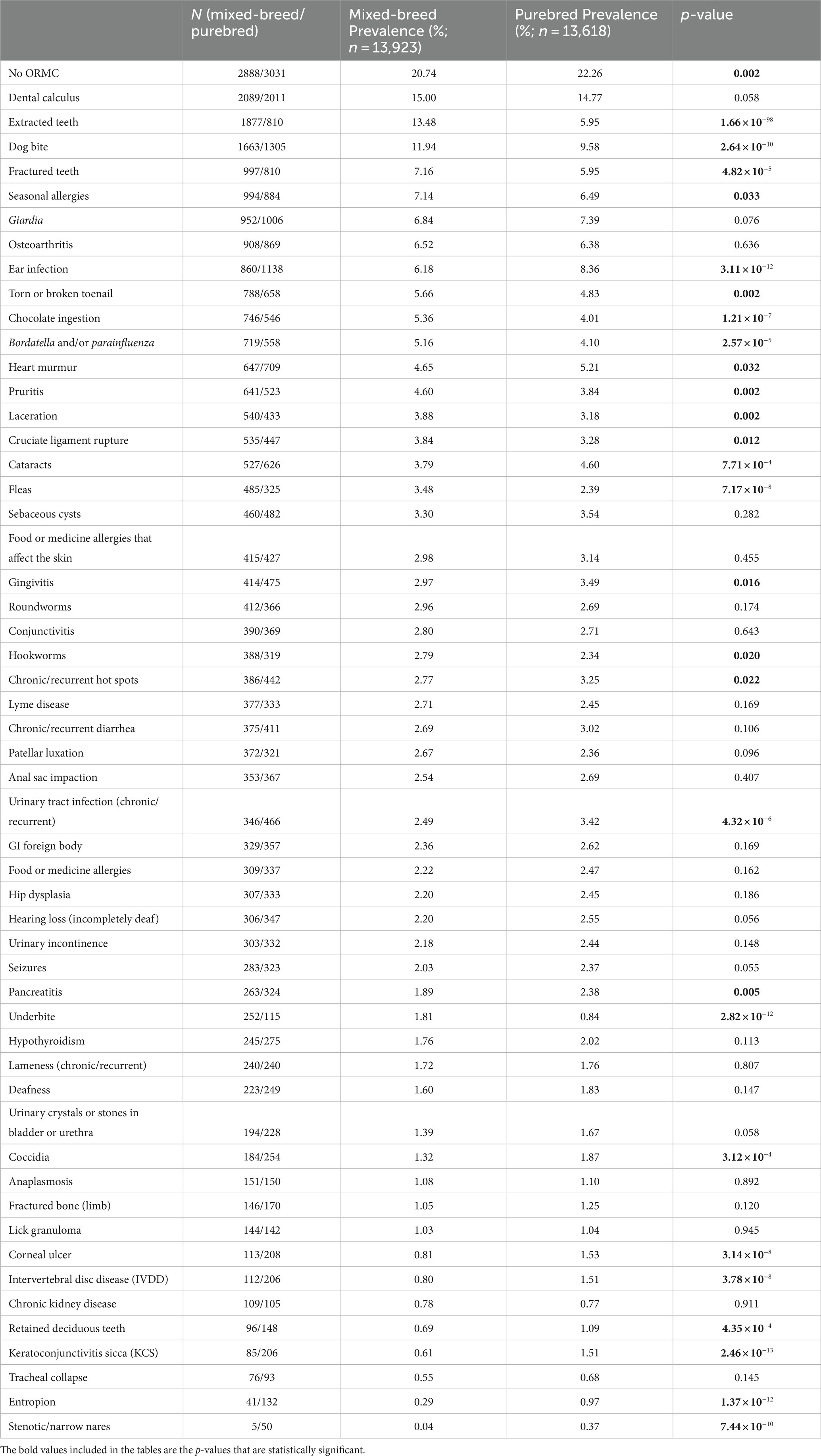
Table 2. Lifetime prevalence of 53 medical conditions in the purebred and mixed-breed dog populations.
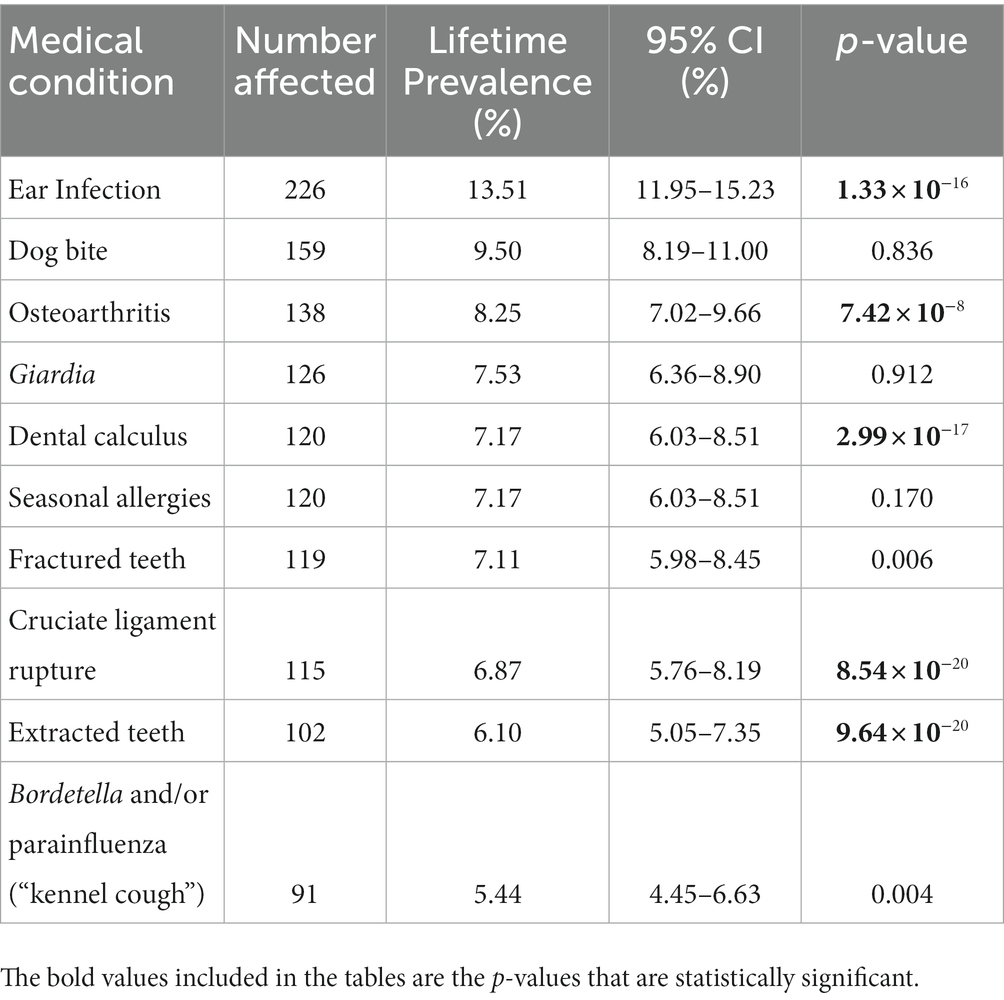
Table 3. Lifetime prevalence of the top 10 medical conditions in Labrador Retrievers compared to the total purebred population.
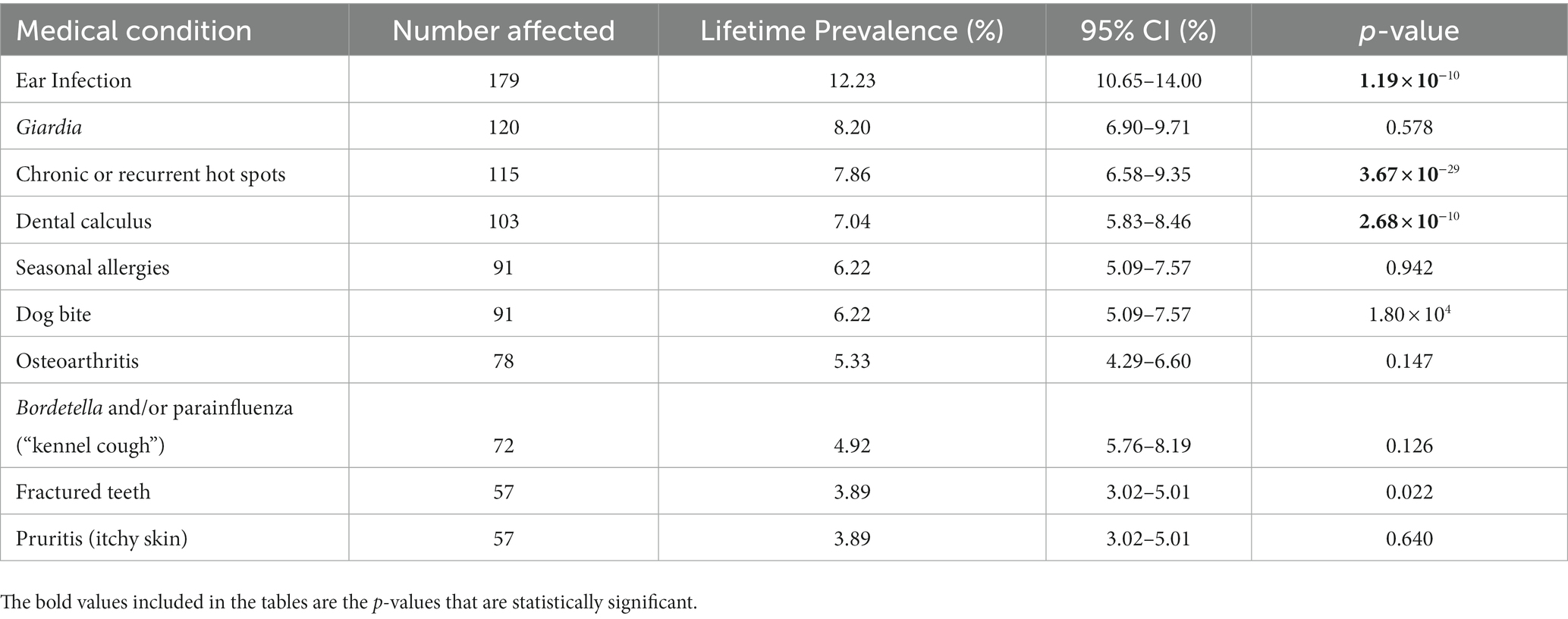
Table 4. Lifetime prevalence of the top 10 medical conditions in Golden Retrievers compared to the total purebred population.
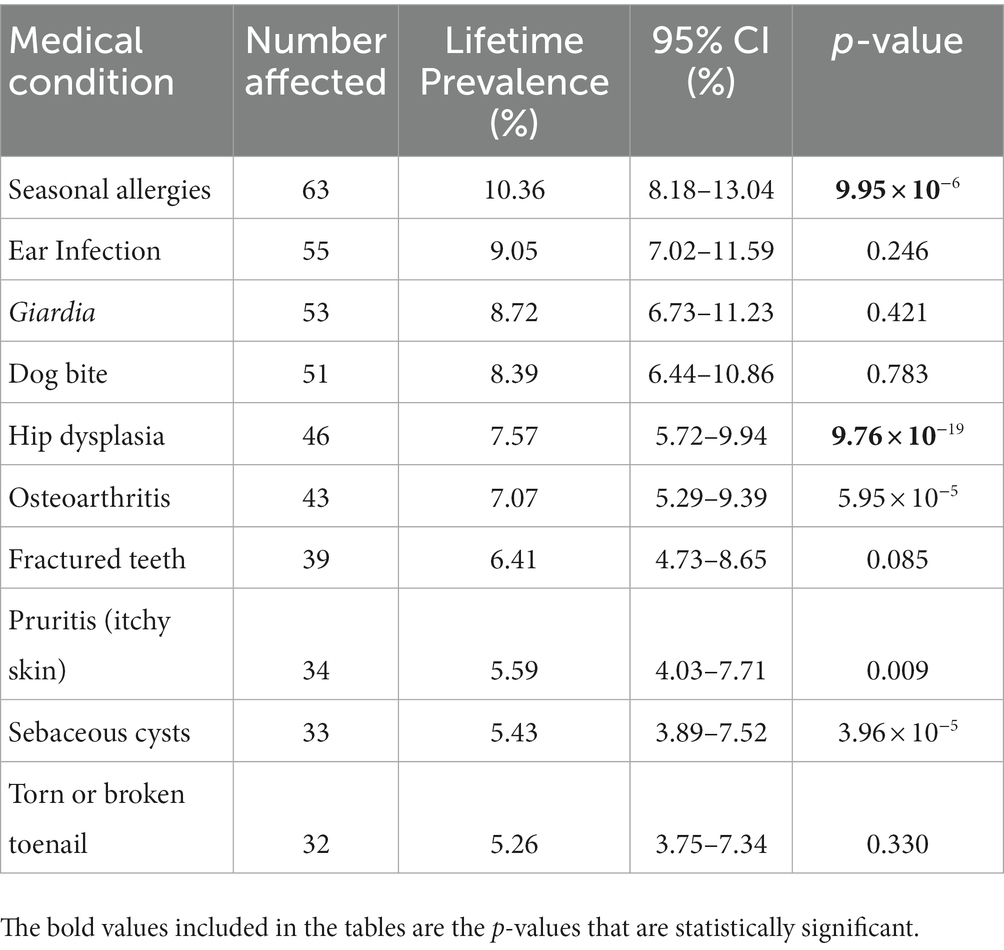
Table 5. Lifetime prevalence of the top 10 medical conditions in German Shepherd Dogs compared to the total purebred population.
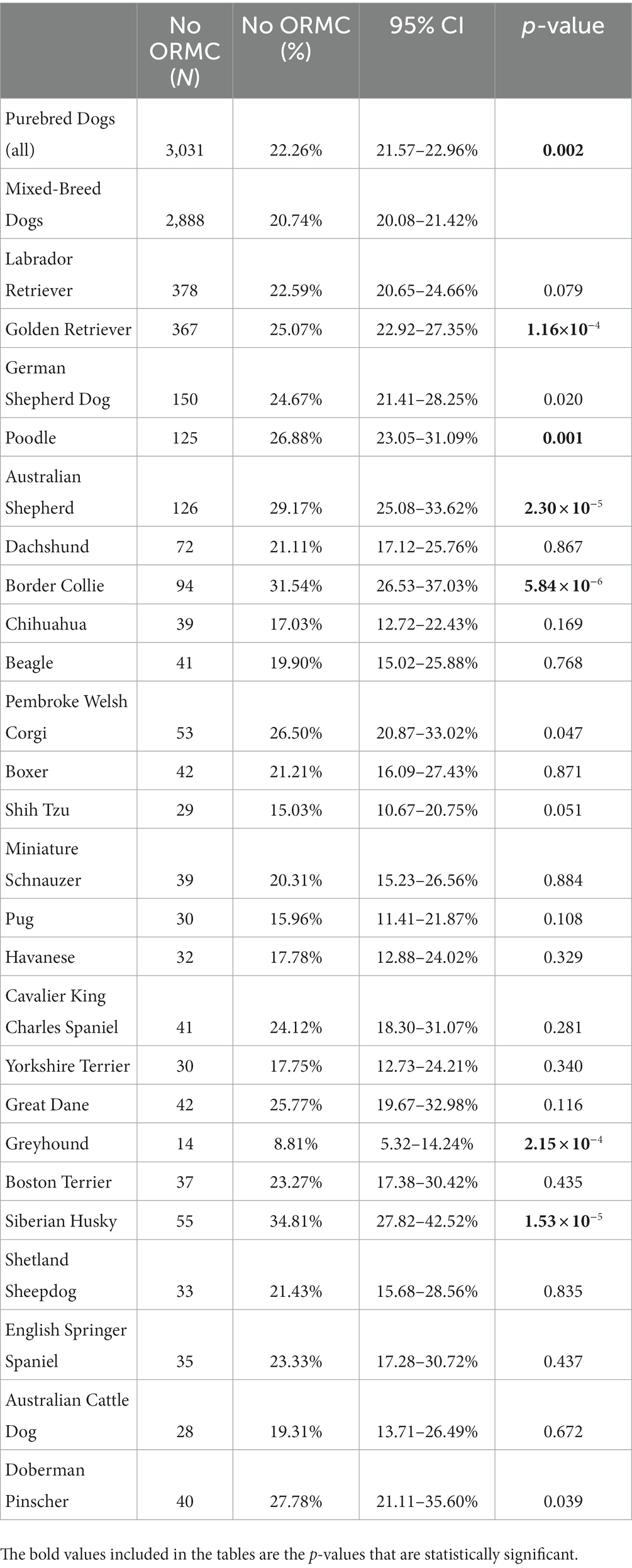
Table 6. Lifetime prevalence of dogs with no owner-reported medical conditions (ORMC) in the total purebred dog population and the 25 most popular individual breeds compared to the mixed-breed dog population.
3. Results
Data from 27,541 companion dogs were included in the study. Of those dogs, 50.6% were mixed-breed dogs (n = 13,923) and 49.4% were purebred dogs (n = 13,618). Of the purebred dogs, the 25 most commonly represented breeds are included in Table 7. These 25 breeds (n = 8,438) make up 62.0% of the purebred dog population and 30.6% of the overall DAP Pack. The remaining 38.0% of purebred dogs included members of 258 breeds. Demographic data describing these breed groups is summarized in Table 7. Both the mean and median life stage for all 25 breeds and the mixed-breed category fell into the mature adult life stage. The distribution of life stages within individual breeds was similar across the 25 breeds.
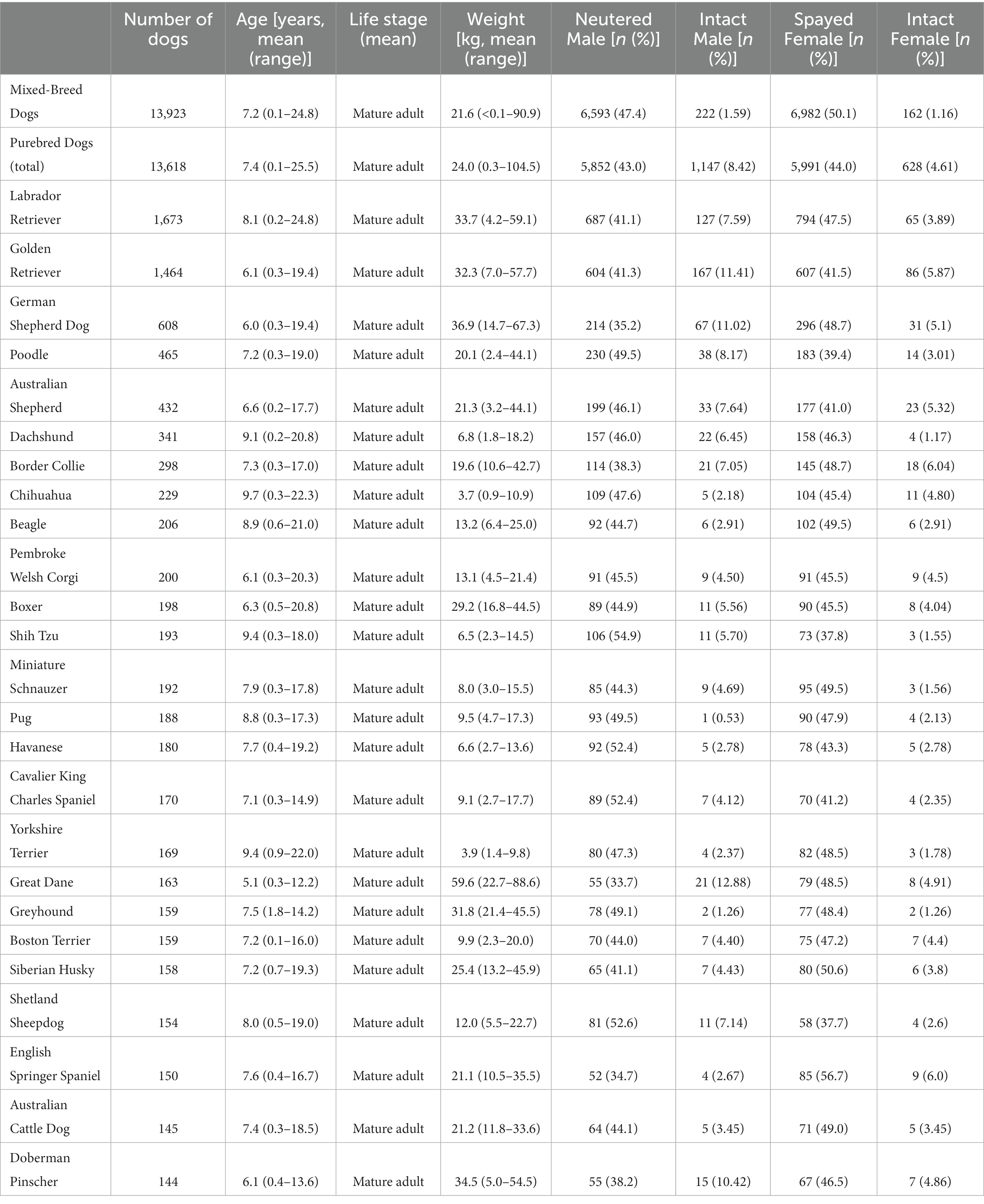
Table 7. Descriptive data for the DAP Pack including mixed-breed dogs, purebred dogs, and the 25 most popular individual breeds.
A total of 53 unique medical conditions were identified making up the top 10 ORMC for these 25 breeds. The top 10 ORMC in mixed-breed dogs were a subset of these 53 medical conditions. The ORMC reported most frequently across breeds were dental calculus, dog bites, extracted teeth, osteoarthritis, and Giardia (Figure 1). Data on all 53 medical conditions and their lifetime prevalence in individual breeds are available in Supplementary Table 1. Data on the top 10 ORMC and their lifetime prevalence in individual breeds are available as Supplementary Table 2. A Heatmap (Figure 2) demonstrates the scaled prevalence of these 53 medical conditions across the 25 most popular dog breeds in the DAP Pack.
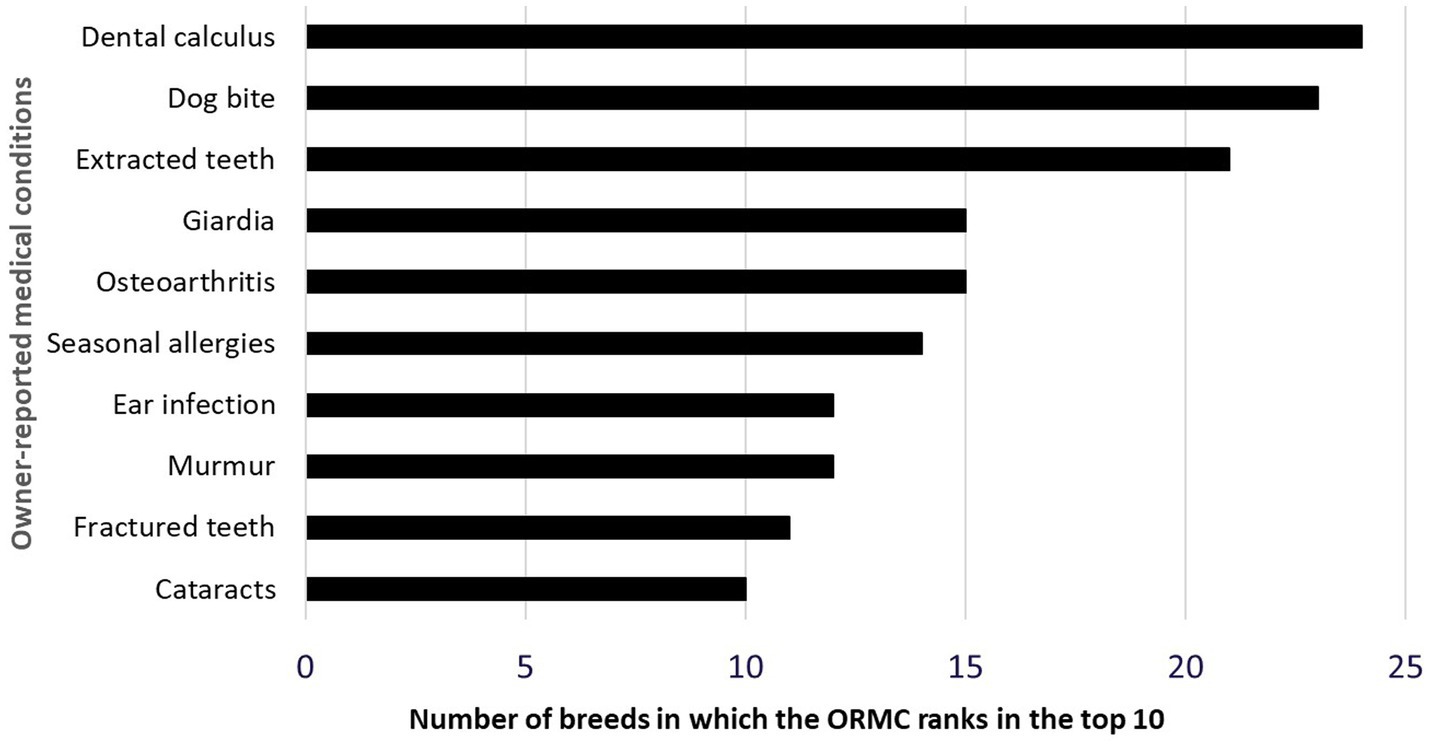
Figure 1. Medical conditions which rank in the top 10 medical conditions in at least 10 of the 25 most popular individual dog breeds in the DAP Pack.
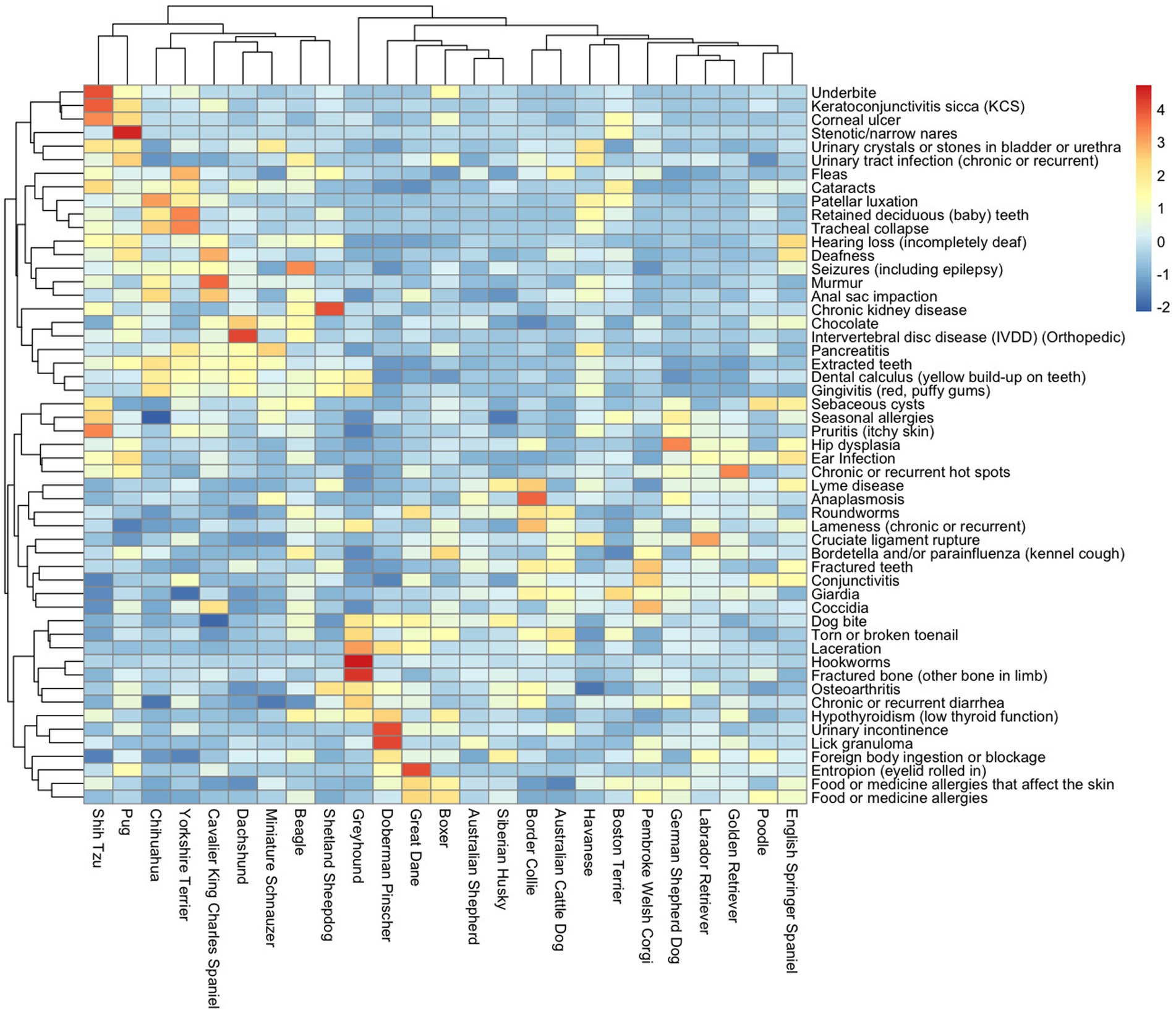
Figure 2. Heatmap showing the scaled lifetime prevalence of the 53 medical conditions (vertical axis) within the 25 most popular individual breeds (horizontal axis) in the DAP pack, with medical condition and breed clustered by similarity. The red color denotes higher lifetime prevalence, while the blue color denotes lower lifetime prevalence.
3.1. Dogs with no reported medical conditions
Purebred dogs (22.3%) were significantly more likely (p = 0.002) to have no ORMC than mixed-breed dogs (20.7%). Considering each breed compared to the population of mixed-breed dogs, significantly more Golden Retrievers (25.1%; p = 1.16 × 10−4), Poodles (26.9%; p = 0.001), Australian Shepherds (29.2%; p = 2.3 × 10−5), Border Collies (31.5%; p = 5.84 × 10−6), and Siberian Huskies (34.8%; p = 1.53 × 10−5) had no ORMC compared to mixed-breed dogs (Table 6). Conversely, the frequency of Greyhounds with no ORMC was significantly lower (8.8%; p = 2.15 × 10−4) than mixed-breed dogs.
3.2. Overall purebred vs. mixed-breed results
A total of 14 ORMC were significantly more prevalent in the overall purebred dog population compared to the overall mixed-breed dog population, and similarly, 13 ORMC were significantly more prevalent in mixed-breed dogs compared to purebred dogs (Table 2). The remaining 26 ORMC were not significantly different between the mixed-breed and purebred dog populations. The most common ORMC in mixed-breed dogs were dental calculus, extracted teeth, dog bite, seasonal allergies, fractured teeth, giardia, osteoarthritis, ear infection, torn or broken toenail, and chocolate toxicity (Table 2).
3.3. Breed specific results
Data on the eight of the most popular breeds are described in detail here; data for the remaining 17 breeds in the top 25 are available in Supplementary Table 2. Additional information including the lifetime prevalence of the other ORMC within the union set of 53 medical conditions that did not rank in the top 10 ORMC within each breed are available in Supplementary Table 1. The top ORMC in Labrador Retrievers were ear infections, dog bites, osteoarthritis, Giardia, dental calculus, seasonal allergies, fractured teeth, cruciate ligament rupture, extracted teeth, and Bordetella and/or parainfluenza (Table 3). Labrador Retrievers were significantly more likely to be reported to have had ear infections (logOR = 0.66, p = 1.33 × 10−16), osteoarthritis (logOR = 0.55, p = 7.42 × 10−8), and cruciate ligament rupture (logOR = 1.03, p = 8.54 × 10−20) compared to other purebred dogs. Labrador Retrievers were significantly less likely to be reported to have dental calculus (logOR = −0.85, p = 2.99 × 10−17) and extracted teeth (logOR = −0.99, p = 9.64 × 10−20) compared to other purebred dogs.
The top ORMC in Golden Retrievers were ear infections, Giardia, chronic/recurrent hot spots, dental calculus, seasonal allergies, dog bites, osteoarthritis, Bordetella and/or parainfluenza, fractured teeth, and pruritis (Table 4). Golden Retrievers were significantly more likely to be reported to have ear infections (logOR = 0.56, p = 1.19 × 10−10) and chronic/ recurrent hot spots (logOR = 1.28, p = 3.67 × 10−29) compared to the overall purebred population. Golden Retrievers were significantly less likely to be reported to have dental calculus (logOR = −0.68,p = 2.68 × 10−10) compared to other purebred dogs.
The top ORMC in German Shepherd Dogs were seasonal allergies, ear infections, Giardia, dog bites, hip dysplasia, osteoarthritis, fractured teeth, pruritis, sebaceous cysts, and torn or broken toenails (Table 5). German Shepherd Dogs were significantly more likely to be reported to have hip dysplasia (logOR = 1.48, p = 9.76 × 10−19) and seasonal allergies (logOR = 0.61, p = 9.95 × 10−6) than other purebred dogs. The lifetime prevalence of the remaining eight ORMC in German Shepherd Dogs were not significantly different compared to other purebred dogs.
Compared to the overall purebred population, the lifetime prevalence of the top 10 ORMC in Australian Shepherds, Australian Cattle Dogs, Boxers, and Siberian Huskies were not significantly different from other purebred dogs (Supplementary Table 1). Both Australian Shepherds and Siberian Huskies were also found to have a significantly higher percentage of dogs with no ORMC than the mixed-breed population (Table 6).
Four of the 10 most commonly reported ORMC in Chihuahuas involved dental conditions: extracted teeth, dental calculus, gingivitis, and retained deciduous teeth (Supplementary Table 2). Specifically, 47.60% (41.22–54.05%) of Chihuahuas were reported to have had teeth extracted and 33.62% (27.82–39.97%) had dental calculus reported. This is significantly more frequently than either of those ORMC were reported in the purebred population (p = 6.12 × 10−22 and p = 4.52 × 10−6, respectively).
4. Discussion
The primary objective of this study was to describe the medical conditions most commonly reported by owners of the most popular breeds in the DAP Pack. Although there was the potential for 250 unique ORMC when looking at the 10 most common conditions for each of the 25 breeds, only 53 ORMC were identified. While the majority of these ORMC only placed in the top 10 for one or two of the 25 breeds, 10 of the ORMC were identified as highly common among at least 10 of the 25 breeds.
Dental calculus was among the top 10 ORMC in 24 of the 25 breeds, and extracted teeth were among the top 10 ORMC in 21 of the 25 breeds. This shows that dental conditions and dental care are relatively common across breeds in the US. Although dental conditions are seen across breeds, certain breeds are impacted more greatly, like Chihuahuas, for whom owners reported dental calculus in approximately one-third of breed members in the DAP Pack and extracted teeth in nearly half the breed members. O’Neill and others reported a 19% prevalence of dental disease among the Chihuahua population in the UK (41); it is possible that the difference is attributable to the fact that their study was a period prevalence estimate for the year 2016, whereas our study considers lifetime prevalence. A 1999 study demonstrated a prevalence of dental calculus at 20.5% as reported by veterinarians for dogs attending private small animal practices in the US (30). This is a higher rate of dental calculus for dogs overall than was noted in our study. This difference may be due to changes in prevalence and improved dental care and prophylaxis over the past 20 years, or may be due to a difference between veterinarian-reported and owner-reported information. Additional studies have shown that dental disorders are one of the most common medical conditions amongst various breeds in the UK (40, 45) and US (17), and dental conditions are a priority area of interest for future health-related welfare improvement in the UK dog population (59), particularly considering that regular veterinary dental scaling is associated with longer lifespan in dogs (63).
Interestingly, dog bite injuries were the second most common ORMC reported across breeds, identified in 23 of the top 25 breeds in the DAP Pack. Most prevalence data for dog bite injuries report on humans being bitten, with scarce data on dogs being bitten by other dogs (5, 23, 29, 49, 61). As a result, there are no recent prevalence data for dog-on-dog bite injuries in the US. The 23 affected breeds included dogs of all body sizes, from toy and small breeds to large and giant breed dogs. While owners and veterinarians may have concern that small dogs may be bitten by larger dogs, this study shows that bite injuries are quite common regardless of size. This highlights the importance of client education along with training and early socialization of dogs, to try to reduce the incidence of bite wounds in the future. Owner-reported dog bite injuries were more common in our study than previously reported in other studies (30); in fact, most prior studies did not even include dog bite injuries or animal bite injuries specifically in their analyses (17, 27, 33, 37–42, 45, 60, 66). It may be that dog bite injuries are being included in more broad categories such as trauma in other studies. Alternatively, it is possible that dog bite injuries are being overlooked in breed-related disease prevalence studies, as trauma of any kind may not be considered a form of disease. The study reported here described individual medical conditions, rather than overarching categories such as “trauma.” Within the category of trauma, conditions that occurred within the top 10 most frequent ORMC for any of the top 25 breeds were dog bite wound, torn or broken toenail, laceration and fractured bone. Other factors, such as lifestyle and environment, likely contribute to risk of medical conditions among dogs, and perhaps more significantly for traumatic conditions. However, it is likely that breed remains a significant risk factor for some traumatic conditions. For instance, certain breeds may be inherently more active, or may be disproportionately chosen by owners for active lifestyles; in either case, breed and environment could interact to increase the risk of traumatic injury. Future studies can further investigate these interrelationships.
The secondary objective of this study was to investigate whether or not there is a difference between purebred or mixed-breed dogs in lifetime prevalence of ORMC, or dogs with no ORMC. This study showed that the lifetime prevalence of dogs with no ORMC was higher in the purebred population (22.3%) compared to the mixed-breed population (20.7%) in the DAP Pack. This is contrary to the common belief that purebred dogs have a greater risk for developing medical conditions due to breed predispositions. This is also a higher proportion of dogs with no medical conditions than the 6.8% reported in the previously mentioned study which used veterinarian-reported data from small animal practices (30). It is possible that the difference between the two studies’ findings reflects the fact that, despite the survey instructions to report all known medical conditions, owners may not recall or choose to report all of their dogs’ medical conditions in the survey-based data used here. Alternatively, it is possible that the DAP Pack captures data from dogs from a general population of healthy dogs who do not require or receive veterinary care and therefore are not represented in manuscripts reporting only data derived from veterinary practice records. This intriguing possibility merits further investigation by determining the frequency of veterinary visits among DAP Pack members, and by comparing owner-reported data to data captured in medical records; such analyses are currently underway by the DAP. Although the difference between dogs with no ORMC in the purebred and mixed-breed populations was statistically significant, the difference was only 1.5%. The mixed-breed population had a significantly higher lifetime prevalence than the purebred population for 13 of the 53 ORMC described here; similarly, the purebred population had a significantly higher lifetime prevalence than the mixed-breed population for 14 of the 53 ORMC as well. Additionally, our study revealed that certain breeds were shown to have a higher lifetime prevalence of specific medical conditions. Overall, 23 of the 25 breeds evaluated showed a significantly increased lifetime prevalence of at least one ORMC when compared to other purebred dogs. Of the breeds evaluated, only the Australian Shepherd, Australian Cattle Dog, Boxer, and Siberian Husky showed no significant difference in lifetime prevalence for their 10 most commonly reported medical conditions when compared to other purebred dogs. Even when evaluating for lifetime prevalence in all 53 of the included ORMC, there was no significant difference in lifetime prevalence for the Australian Cattle Dog and Siberian Husky compared to other purebred dogs (Supplementary Table 1). Similarly, the Australian Shepherd and Siberian Husky were the breeds with the highest frequency of dogs with no ORMC in our study and significantly more dogs from these breeds had no ORMC compared to the mixed-breed population. Because the data utilized in this study are owner-reported and individual medical records associated with each dog were not evaluated as part of this study, we are unable to determine the severity of the ORMC or how that severity might vary between breeds. Future studies of severity of disease among breeds, and response to therapies deployed, are important targets of this research.
The most common breeds and ORMC seen in the DAP Pack are likely to be representative of the United States canine population. Most previous studies evaluating dogs within the US have been performed at veterinary referral centers (6, 16, 54) or within a single large private-practice chain (44, 50, 55). This creates a bias as these studies do not include dogs whose owners are unable to or elect not to pursue veterinary specialty referral (3), or target only a particular consumer group who may not be representative of the overall population. Because the dogs within the DAP Pack are recruited directly from owners, not through veterinarians or veterinary clinics, there is the possibility to include dogs who are evaluated by veterinarians less frequently, who are never seen at veterinary referral centers, and potentially those who have never seen a veterinarian at all. Any owner within the US can sign up at any time. While there is currently a trend towards older dogs and older owners within the DAP Pack, the DAP is actively recruiting for dogs of all ages and owners from more varying backgrounds. There is also a trend towards dogs which have been neutered within the DAP Pack. Because the majority of dogs within the DAP Pack are neutered, sex, neuter status, and age of neutering have not been assessed within this study. This is a limitation of this study, as these factors can influence medical conditions (21, 22).
The top 25 breeds making up the DAP Pack vary somewhat when compared to the top 25 breeds according to AKC registration numbers for 2020. Border Collie, Chihuahua, Pug, Greyhound, Shetland Sheepdog, and English Springer Spaniel all ranked higher in the DAP Pack than they did in AKC registration, as they were not even included in the AKC top 25 breeds (2). These differences between the reported AKC numbers and DAP Pack numbers are likely due to the fact that there are many purebred dogs in the US that are never registered with the AKC. Greyhounds are an excellent example of this as many of the Greyhounds in the DAP Pack are retired racing dogs, which are often registered with the National Greyhound Association instead of the AKC (36). It is also possible that this is the reason our study found significantly fewer greyhounds with no ORMC, as many racing greyhounds are retired due to injuries. However, despite these differences there are also similarities between popular DAP Pack and AKC breeds, such as the top 3 breeds in the DAP Pack ranking within the top 4 breeds in the AKC (2). This study classified all mixed-breed dogs as part of the mixed-breed population, including new “designer breeds” such as goldendoodles or cockapoos. While designer breeds are actually F1 hybrids and not purebred dog breeds, many are becoming popular within the United States. As a result, performing a similar study evaluating F1 hybrids as a third breed-background group could provide useful information for practicing veterinarians in the United States.
One of the main limitations of this study is that the data were collected through owner-reported survey results, meaning there is an inherent risk of recall bias and reporting bias affecting results. This may be because of lack of understanding of one or more conditions, lack of recollection of one or more condition and/or lack of comprehensive diagnostic investigation of one or more conditions. With these limitations in mind, our survey was intentionally designed to include clinical signs, as well as discrete diagnoses, among the options presented to participants. Additionally, data were intentionally analyzed as reported, and no attempt was made to interpret responses as components of a larger disease syndrome, or to assume the presence of common comorbidities. No previous large studies have been performed analyzing the accuracy of owner-reported medical data in veterinary medicine. Further research comparing owner-reported survey data to veterinary medical records is needed. Studies in human pediatrics show reasonable accuracy in parental recall of children’s health information, with greater accuracy for acute and significant health events (4, 11, 14, 19, 24, 34, 51–53, 57). Assuming that dog owners will have similar recall accuracy and biases as parents completing surveys about their children’s health, it is reasonable to assume that owner-reported surveys will be relatively accurate to their dog’s medical conditions with a potential bias towards recalling medical conditions which owners regard as more significant. As a result, this study may highlight those medical conditions that owners most recall or are most concerned about for their dogs. This means that there may be an underrepresentation of medical conditions that owners do not find concerning, or a lack of recognition of all components of a given medical syndrome by some respondents. An example of this is the low lifetime prevalence of stenotic nares, underbite, and tracheal collapse in this study. These three conditions were each reported in less than 1% of the purebred population and less than 2% of the mixed-breed population, much less frequent than reported in previous studies (25, 28, 31). Stenotic nares and underbite are often associated with brachycephalic breeds and may potentially be considered a breed standard in some, and as a result may not be recognized as a medical condition by owners or veterinarians (28, 46, 47). Furthermore, dogs with externally apparent brachycephalic features often have hypoplastic trachea as well (7, 26, 56), which less likely to be apparent to an owner, and may be under-reported in our data. We did not attempt to re-classify reports of external brachycephalic features into an overarching diagnosis of “brachycephalic syndrome” that assumed hypoplastic trachea was also present. Additional studies comparing ORMC to what is reported in the medical records are indicated to determine the accuracy of survey data in veterinary medicine.
Another limitation is the risk that owners will only recall the most recent medical conditions, resulting in underreporting of congenital disorders or medical conditions more commonly associated with young age. While dogs of all ages were included in this study, the DAP Pack is predominantly older dogs with the median ages of the different breeds ranging from 5.1 years (Great Dane) to 9.7 years (Chihuahua). All the breeds included in this study and the mixed-breed category had a majority of the participating dogs in the mature adult life stage. If owners do fail to recall medical conditions that were further in the past, the median age of the DAP Pack population may lead to a reporting towards medical conditions more common in older dogs. However, since the median life stages are similar among breeds in the DAP Pack, there should be minimal age-related biases in direct breed-to-breed comparisons. Furthermore, as the DAP is a longitudinal study, ORMC will be collected each year which will make it possible to construct a more accurate description of the timing of ORMC acquisition across the lifespan.
Another limitation of this study is that sex, neuter status, and age of neutering were not assessed in relation to the ORMC.
Overall, our study found that purebred dogs did not have an increased lifetime prevalence of ORMC compared to mixed-breed dogs; in fact the frequency of dogs with no ORMC was higher within the purebred population. However, specific breeds often show an increased lifetime prevalence of certain medical conditions. As a result, it is important for veterinarians to consider potential breed predispositions when monitoring and treating their patients. This study also revealed that dental conditions and dog bites are common across breeds, and as a result prevention for these conditions should be addressed by primary care veterinarians.
Data availability statement
The datasets presented in this study can be found in online repositories. The names of the repository/repositories and accession number(s) can be found at: https://dogagingproject.org/open_data_access/.
Ethics statement
The University of Washington IRB deemed that recruitment of dog owners for the Dog Aging Project, and the administration and content of the DAP Health and Life Experience Survey (HLES), are human subjects research that qualifies for Category 2 exempt status (IRB ID no. 5988, effective 10/30/2018). No interactions between researchers and privately owned dogs occurred; therefore, IACUC oversight was not required. The studies were conducted in accordance with the local legislation and institutional requirements. The participants provided their written informed consent to participate in this study.
Author contributions
The DAP Consortium designed the DAP study, implemented data collection, and developed and curated the DAP databases. KKF, KEC, and SS designed the specific study. KKF, BMM, NS-M, and DELP completed the analyses and made the figures. KKF wrote the first draft of the manuscript. All authors contributed to the article and approved the submitted version.
DAP Consortium
Joshua M. Akey1, Brooke Benton2, Elhanan Borenstein3,4,5, Marta G. Castelhano6,7, Amanda E. Coleman8, Kate E. Creevy9, Kyle Crowder10,11, Matthew D. Dunbar11, Virginia R. Fajt12, Annette L. Fitzpatrick13,14,15, Unity Jeffery16, Erica C Jonlin2,17, Matt Kaeberlein2, Elinor K. Karlsson18,19, Kathleen F. Kerr20, Jonathan M. Levine9, Jing Ma21, Robyn L McClelland20, Daniel E. L. Promislow2,22, Audrey Ruple23, Stephen M. Schwartz24,14, Sandi Shrager25, Noah Snyder-Mackler26,27,28, M. Katherine Tolbert9, Silvan R. Urfer2, Benjamin S. Wilfond29,30
1Lewis-Sigler Institute for Integrative Genomics, Princeton University, Princeton, NJ, United States
2Department of Laboratory Medicine and Pathology, University of Washington School of Medicine, Seattle, WA, United States
3Department of Clinical Microbiology and Immunology, Sackler Faculty of Medicine, Tel Aviv University, Tel Aviv, Israel
4Blavatnik School of Computer Science, Tel Aviv University, Tel Aviv, Israel
5Santa Fe Institute, Santa Fe, NM, United States
6Cornell Veterinary Biobank, College of Veterinary Medicine, Cornell University, Ithaca, NY, United States
7Department of Clinical Sciences, College of Veterinary Medicine, Cornell University, Ithaca, NY, United States
8Department of Small Animal Medicine and Surgery, College of Veterinary Medicine, University of Georgia, Athens, GA, United States
9Department of Small Animal Clinical Sciences, Texas A&M University College of Veterinary Medicine & Biomedical Sciences, College Station, TX, United States
10Department of Sociology, University of Washington, Seattle, WA, United States
11Center for Studies in Demography and Ecology, University of Washington, Seattle, WA, United States
12Department of Veterinary Physiology and Pharmacology, Texas A&M University College of Veterinary Medicine and Biomedical Sciences, College Station, TX, United States
13Department of Family Medicine, University of Washington, Seattle, WA, United States
14Department of Epidemiology, University of Washington, Seattle, WA, United States
15Department of Global Health, University of Washington, Seattle, WA, United States
16Department of Veterinary Pathobiology, Texas A&M University College of Veterinary Medicine & Biomedical Sciences, College Station, TX, United States
17Institute for Stem Cell and Regenerative Medicine, University of Washington, Seattle, WA, United States
18Bioinformatics and Integrative Biology, University of Massachusetts Chan Medical School, Worcester, MA, United States
19Broad Institute of MIT and Harvard, Cambridge, MA, United States
20Department of Biostatistics, University of Washington, Seattle, WA, United States
21Division of Public Health Sciences, Fred Hutchinson Cancer Research Center, Seattle, WA, United States
22Department of Biology, University of Washington, Seattle, WA, United States
23Department of Population Health Sciences, Virginia-Maryland College of Veterinary Medicine, Virginia Tech, Blacksburg, VA, United States
24Epidemiology Program, Fred Hutchinson Cancer Research Center, Seattle, WA, United States
25Collaborative Health Studies Coordinating Center, Department of Biostatistics, University of Washington, Seattle, WA, United States
26School of Life Sciences, Arizona State University, Tempe, AZ, United States
27Center for Evolution and Medicine, Arizona State University, Tempe, AZ, United States
28School for Human Evolution and Social Change, Arizona State University, Tempe, AZ, United States
29Treuman Katz Center for Pediatric Bioethics, Seattle Children’s Research Institute, Seattle, WA, United States
30Department of Pediatrics, Division of Bioethics and Palliative Care, University of Washington School of Medicine, Seattle, WA, United States
Funding
The Dog Aging Project is supported by National Institute on Aging grant U19AG057377 (PI: Promislow) and private donations. This content is solely the responsibility of the authors and does not necessarily reflect the official views of the National Institutes of Health.
Acknowledgments
We would like to thank the Dog Aging Project participants, their dogs, and community veterinarians for their important contributions to the Dog Aging Project.
Conflict of interest
The authors declare that the research was conducted in the absence of any commercial or financial relationships that could be construed as a potential conflict of interest.
Publisher’s note
All claims expressed in this article are solely those of the authors and do not necessarily represent those of their affiliated organizations, or those of the publisher, the editors and the reviewers. Any product that may be evaluated in this article, or claim that may be made by its manufacturer, is not guaranteed or endorsed by the publisher.
Supplementary material
The Supplementary material for this article can be found online at: https://www.frontiersin.org/articles/10.3389/fvets.2023.1140417/full#supplementary-material
References
1. American-Kennel-Club (2021). Becoming Recognized by the AKC: The American Kennel Club Inc. Available at: https://www.akc.org/press-center/articles-resources/facts-and-stats/becoming-recognized/ (Accessed February 1, 2023).
2. American-Kennel-Club (2021). The Most popular dog breeds of 2020: The American Kennel Club Inc. Available at: https://www.akc.org/expert-advice/dog-breeds/the-most-popular-dog-breeds-of-2020/ (Accessed February 1, 2023).
3. Bartlett, PC , Van Buren, JW , Neterer, M , and Zhou, C . Disease surveillance and referral bias in the veterinary medical database. Prev Vet Med. (2010) 94:264–71. doi: 10.1016/j.prevetmed.2010.01.007
4. Binyaruka, P , and Borghi, J . Validity of parental recalls to estimate vaccination coverage: evidence from Tanzania. BMC Health Serv Res. (2018) 18:440. doi: 10.1186/s12913-018-3270-z
5. Brooks, A , Moxon, R , and England, GCW . Incidence and impact of dog attacks on guide dogs in the UK. Vet Rec. (2010) 166:778–81. doi: 10.1136/vr.b4855
6. Bryan, JN , Keeler, MR , Henry, CJ , Bryan, ME , Hahn, AW , and Caldwell, CW . A population study of neutering status as a risk factor for canine prostate cancer. Prostate. (2007) 67:1174–81. doi: 10.1002/pros.20590
7. Coyne, BE , and Fingland, RB . Hypoplasia of the trachea in dogs: 103 cases (1974-1990). J Am Vet Med Assoc. (1992) 201:768–72.
8. Creevy, KE , Akey, JM , Kaeberlein, M , Promislow, DEL , Barnett, BG , Benton, B, et al. An open science study of ageing in companion dogs. Nature. (2022) 602:51–7. doi: 10.1038/s41586-021-04282-9
9. Creevy, KE , Grady, J , Little, SE , Moore, GE , Strickler, BG , Thompson, S, et al. 2019 AAHA Canine Life Stage Guidelines. J Am Anim Hosp Assoc. (2019) 55:267–90. doi: 10.5326/JAAHA-MS-6999
10. Crnokrak, P , and Barrett, SC . Perspective: purging the genetic load: a review of the experimental evidence. Evolution. (2002) 56:2347–58. doi: 10.1111/j.0014-3820.2002.tb00160.x
11. Cummings, P , Rivara, FP , Thompson, RS , and Reid, RJ . Ability of parents to recall the injuries of their young children. Inj Prev. (2005) 11:43–7. doi: 10.1136/ip.2004.006833
12. Dodds, WJ . Estimating disease prevalence with health surveys and genetic screening. Adv Vet Sci Comp Med. (1995) 39:29–96. doi: 10.1016/S0065-3519(06)80017-0
13. Dog-Aging-Project (2021). Dog Aging Project Survey Instruments: GitHub Inc. Available at: https://github.com/dogagingproject/survey_instruments/tree/main/HLES/annotated_with_terra_names
14. D'Souza-Vazirani, D , Minkovitz, CS , and Strobino, DM . Validity of maternal report of acute health care use for children younger than 3 years. Arch Pediatr Adolesc Med. (2005) 159:167–72. doi: 10.1001/archpedi.159.2.167
15. Egenvall, A , Nødtvedt, A , Häggström, J , Ström Holst, B , Möller, L , and Bonnett, BN . Mortality of life-insured Swedish cats during 1999-2006: age, breed, sex, and diagnosis. J Vet Intern Med. (2009) 23:1175–83. doi: 10.1111/j.1939-1676.2009.0396.x
16. Fleming, JM , Creevy, KE , and Promislow, DE . Mortality in north American dogs from 1984 to 2004: an investigation into age-, size-, and breed-related causes of death. J Vet Intern Med. (2011) 25:187–98. doi: 10.1111/j.1939-1676.2011.0695.x
17. Freeman, LM , Abood, SK , Fascetti, AJ , Fleeman, LM , Michel, KE , Laflamme, DP, et al. Disease prevalence among dogs and cats in the United States and Australia and proportions of dogs and cats that receive therapeutic diets or dietary supplements. J Am Vet Med Assoc. (2006) 229:531–4. doi: 10.2460/javma.229.4.531
18. Galis, F , Van der Sluijs, I , Van Dooren, TJ , Metz, JA , and Nussbaumer, M . Do large dogs die young? J Exp Zool B Mol Dev Evol. (2007) 308:119–26. doi: 10.1002/jez.b.21116
19. Gareaballah, ET , and Loevinsohn, BP . The accuracy of mother's reports about their children's vaccination status. Bull World Health Organ. (1989) 67:669–74.
20. Gough, A , and Thomas, A . Breed predispositions to disease in dogs and cats, vol. xvii. 2nd ed. Chichester, West Sussex; Ames, Iowa: Wiley-Blackwell (2010). 330 p.
21. Hart, BL , Hart, LA , Thigpen, AP , and Willits, NH . Assisting decision-making on age of neutering for mixed breed dogs of five weight categories: associated joint disorders and cancers. Front Vet Sci. (2020) 7:472. doi: 10.3389/fvets.2020.00472
22. Hart, BL , Hart, LA , Thigpen, AP , and Willits, NH . Assisting decision-making on age of neutering for 35 breeds of dogs: associated joint disorders, cancers, and urinary incontinence. Front Vet Sci. (2020) 7:388. doi: 10.3389/fvets.2020.00388
23. Heyward, CL , Hazel, S , Peacock, R , and Nielsen, T . Characteristics and outcomes of dog attacks to dogs and cats in Melbourne, Australia: a retrospective study of 459 cases (2018). Prev Vet Med. (2022) 201:105609. doi: 10.1016/j.prevetmed.2022.105609
24. Infante-Rivard, C , and Jacques, L . Empirical study of parental recall bias. Am J Epidemiol. (2000) 152:480–6. doi: 10.1093/aje/152.5.480
25. Johnson, LR , and Pollard, RE . Tracheal collapse and bronchomalacia in dogs: 58 cases (7/2001–1/2008). J Vet Intern Med. (2010) 24:298–305. doi: 10.1111/j.1939-1676.2009.0451.x
26. Kaye, BM , Boroffka, SA , Haagsman, AN , and Ter Haar, G . Computed tomographic, radiographic, and endoscopic tracheal dimensions in English bulldogs with grade 1 clinical signs of brachycephalic airway syndrome. Vet Radiol Ultrasound. (2015) 56:609–16. doi: 10.1111/vru.12277
27. Kim, E , Choe, C , Yoo, JG , Oh, SI , Jung, Y , Cho, A, et al. Major medical causes by breed and life stage for dogs presented at veterinary clinics in the Republic of Korea: a survey of electronic medical records. PeerJ. (2018) 6:e5161. doi: 10.7717/peerj.5161
28. Liu, NC , Troconis, EL , Kalmar, L , Price, DJ , Wright, HE , Adams, VJ, et al. Conformational risk factors of brachycephalic obstructive airway syndrome (BOAS) in pugs, French bulldogs, and bulldogs. PLoS One. (2017) 12:e0181928. doi: 10.1371/journal.pone.0181928
29. Loder, RT . The demographics of dog bites in the United States. Heliyon. (2019) 5:e01360. doi: 10.1016/j.heliyon.2019.e01360
30. Lund, EM , Armstrong, PJ , Kirk, CA , Kolar, LM , and Klausner, JS . Health status and population characteristics of dogs and cats examined at private veterinary practices in the United States. J Am Vet Med Assoc. (1999) 214:1336–41.
31. Marolf, A , Blaik, M , and Specht, A . A retrospective study of the relationship between tracheal collapse and bronchiectasis in dogs. Vet Radiol Ultrasound. (2007) 48:199–203. doi: 10.1111/j.1740-8261.2007.00229.x
32. Martin, MW , Stafford Johnson, MJ , and Celona, B . Canine dilated cardiomyopathy: a retrospective study of signalment, presentation and clinical findings in 369 cases. J Small Anim Pract. (2009) 50:23–9. doi: 10.1111/j.1748-5827.2008.00659.x
33. McGreevy, PD , Wilson, BJ , Mansfield, CS , Brodbelt, DC , Church, DB , Dhand, N, et al. Labrador retrievers under primary veterinary care in the UK: demography, mortality and disorders. Canine Genet Epidemiol. (2018) 5:8. doi: 10.1186/s40575-018-0064-x
34. Modi, RN , King, C , Bar-Zeev, N , and Colbourn, T . Caregiver recall in childhood vaccination surveys: systematic review of recall quality and use in low- and middle-income settings. Vaccine. (2018) 36:4161–70. doi: 10.1016/j.vaccine.2018.05.089
35. Morrill, K , Hekman, J , Li, X , McClure, J , Logan, B , Goodman, L, et al. Ancestry-inclusive dog genomics challenges popular breed stereotypes. Science. (2022) 376:eabk0639. doi: 10.1126/science.abk0639
36. National-Greyhound-Association (2021). National Greyhound Association. Available at: https://www.ngagreyhounds.com/ (Accessed February 1, 2023).
37. O’Neill, DG , Butcher, C , Church, DB , Brodbelt, DC , and Gough, AG . Miniature schnauzers under primary veterinary care in the UK in 2013: demography, mortality and disorders. Canine Genet Epidemiol. (2019) 6:1. doi: 10.1186/s40575-019-0069-0
38. O’Neill, DG , Coulson, NR , Church, DB , and Brodbelt, DC . Demography and disorders of German shepherd dogs under primary veterinary care in the UK. Canine Genet Epidemiol. (2017) 4:7. doi: 10.1186/s40575-017-0046-4
39. O’Neill, DG , Darwent, EC , Church, DB , and Brodbelt, DC . Demography and health of pugs under primary veterinary care in England. Canine Genet Epidemiol. (2016) 3:5. doi: 10.1186/s40575-016-0035-z
40. O’Neill, DG , James, H , Brodbelt, DC , Church, DB , and Pegram, C . Prevalence of commonly diagnosed disorders in UK dogs under primary veterinary care: results and applications. BMC Vet Res. (2021) 17:69. doi: 10.1186/s12917-021-02775-3
41. O’Neill, DG , Packer, RMA , Lobb, M , Church, DB , Brodbelt, DC , and Pegram, C . Demography and commonly recorded clinical conditions of Chihuahuas under primary veterinary care in the UK in 2016. BMC Vet Res. (2020) 16:42. doi: 10.1186/s12917-020-2258-1
42. O’Neill, DG , Rooney, NJ , Brock, C , Church, DB , Brodbelt, DC , and Pegram, C . Greyhounds under general veterinary care in the UK during 2016: demography and common disorders. Canine Genet Epidemiol. (2019) 6:4. doi: 10.1186/s40575-019-0072-5
43. Oberbauer, AM , Belanger, JM , Bellumori, T , Bannasch, DL , and Famula, TR . Ten inherited disorders in purebred dogs by functional breed groupings. Canine Genet Epidemiol. (2015) 2:9. doi: 10.1186/s40575-015-0021-x
44. Okafor, CC , Lefebvre, SL , Pearl, DL , Yang, M , Wang, M , Blois, SL, et al. Risk factors associated with calcium oxalate urolithiasis in dogs evaluated at general care veterinary hospitals in the United States. Prev Vet Med. (2014) 115:217–28. doi: 10.1016/j.prevetmed.2014.04.006
45. O'Neill, DG , Church, DB , McGreevy, PD , Thomson, PC , and Brodbelt, DC . Prevalence of disorders recorded in dogs attending primary-care veterinary practices in England. PLoS One. (2014) 9:e90501. doi: 10.1371/journal.pone.0091532
46. Packer, RMA , Hendricks, A , and Burn, CC . Do dog owners perceive the clinical signs related to conformational inherited disorders as 'normal' for the breed? A potential constraint to improving canine welfare. Anim Welf. (2012) 21:81–93. doi: 10.7120/096272812X13345905673809
47. Packer, RM , and Tivers, MS . Strategies for the management and prevention of conformation-related respiratory disorders in brachycephalic dogs. Vet Med. (2015) 6:219–32. doi: 10.2147/VMRR.S60475
48. Parker, HG , Meurs, KM , and Ostrander, EA . Finding cardiovascular disease genes in the dog. J Vet Cardiol. (2006) 8:115–27. doi: 10.1016/j.jvc.2006.04.002
49. Patronek, GJ , and Slavinski, SA . Animal bites. J Am Vet Med Assoc. (2009) 234:336–45. doi: 10.2460/javma.234.3.336
50. Plant, JD , Lund, EM , and Yang, M . A case-control study of the risk factors for canine juvenile-onset generalized demodicosis in the USA. Vet Dermatol. (2011) 22:95–9. doi: 10.1111/j.1365-3164.2010.00922.x
51. Pless, CE , and Pless, IB . How well they remember. The accuracy of parent reports. Arch Pediatr Adolesc Med. (1995) 149:553–8. doi: 10.1001/archpedi.1995.02170180083016
52. Porth, JM , Wagner, AL , Tefera, YA , and Boulton, ML . Childhood immunization in Ethiopia: accuracy of maternal recall compared to vaccination cards. Vaccines. (2019) 7:313–18. doi: 10.3390/vaccines7020048
53. Rafferty, E , Hetherington, E , Tough, S , Aujla, S , McNeil, D , Saini, V, et al. The impact of time since vaccination and study design on validity in parental recall of childhood vaccination status in the all our families cohort. Vaccine. (2018) 36:2953–9. doi: 10.1016/j.vaccine.2018.04.045
54. Raghavan, M , Glickman, N , Moore, G , Caldanaro, R , Lewis, H , and Glickman, L . Prevalence of and risk factors for canine tick infestation in the United States, 2002-2004. Vector Borne Zoonotic Dis. (2007) 7:65–75. doi: 10.1089/vbz.2006.0570
55. Rettenmaier, JL , Keller, GG , Lattimer, JC , Corley, EA , and Ellersieck, MR . Prevalence of canine hip dysplasia in a veterinary teaching hospital population. Vet Radiol Ultrasound. (2002) 43:313–8. doi: 10.1111/j.1740-8261.2002.tb01010.x
56. Riecks, TW , Birchard, SJ , and Stephens, JA . Surgical correction of brachycephalic syndrome in dogs: 62 cases (1991-2004). J Am Vet Med Assoc. (2007) 230:1324–8. doi: 10.2460/javma.230.9.1324
57. Spencer, NJ , and Coe, C . Validation of the Warwick child health and morbidity profile in routine child health surveillance. Child Care Health Dev. (2000) 26:323–36. doi: 10.1046/j.1365-2214.2000.00148.x
58. Summers, JF , Diesel, G , Asher, L , McGreevy, PD , and Collins, LM . Inherited defects in pedigree dogs. Part 2: disorders that are not related to breed standards. Vet J. (2010) 183:39–45. doi: 10.1016/j.tvjl.2009.11.002
59. Summers, JF , O’Neill, DG , Church, D , Collins, L , Sargan, D , and Brodbelt, DC . Health-related welfare prioritisation of canine disorders using electronic health records in primary care practice in the UK. BMC Vet Res. (2019) 15:163. doi: 10.1186/s12917-019-1902-0
60. Summers, JF , O’Neill, DG , Church, DB , Thomson, PC , McGreevy, PD , and Brodbelt, DC . Prevalence of disorders recorded in Cavalier King Charles Spaniels attending primary-care veterinary practices in England. Canine Genet Epidemiol. (2015) 2:4. doi: 10.1186/s40575-015-0016-7
61. Tuckel, PS , and Milczarski, W . The changing epidemiology of dog bite injuries in the United States, 2005–2018. Inj Epidemiol. (2020) 7:57. doi: 10.1186/s40621-020-00281-y
62. Urfer, SR , Kaeberlein, M , Promislow, DEL , and Creevy, KE . Lifespan of companion dogs seen in three independent primary care veterinary clinics in the United States. Canine Med Genet. (2020) 7:7. doi: 10.1186/s40575-020-00086-8
63. Urfer, SR , Wang, M , Yang, M , Lund, EM , and Lefebvre, SL . Risk factors associated with lifespan in pet dogs evaluated in primary care veterinary hospitals. J Am Anim Hosp Assoc. (2019) 55:130–7. doi: 10.5326/JAAHA-MS-6763
64. Wayne, RK , and Ostrander, EA . Lessons learned from the dog genome. Trends Genet. (2007) 23:557–67. doi: 10.1016/j.tig.2007.08.013
65. Wellmann, R , and Pfeiffer, I . Pedigree analysis for conservation of genetic diversity and purging. Genet Res. (2009) 91:209–19. doi: 10.1017/S0016672309000202
Keywords: lifetime prevalence, purebred, mixed-breed, epidemiology, cross-sectional
Citation: Forsyth KK, McCoy BM, Schmid SM, Promislow DEL, Snyder-Mackler N, the DAP Consortium and Creevy KE (2023) Lifetime prevalence of owner-reported medical conditions in the 25 most common dog breeds in the Dog Aging Project pack. Front. Vet. Sci. 10:1140417. doi: 10.3389/fvets.2023.1140417
Edited by:
Galileu Barbosa Costa, United States Food and Drug Administration, United StatesReviewed by:
Susan Hazel, University of Adelaide, AustraliaBenjamin Hart, University of California, Davis, United States
Copyright © 2023 Forsyth, McCoy, Schmid, Promislow, Snyder-Mackler, the DAP Consortium and Creevy. This is an open-access article distributed under the terms of the Creative Commons Attribution License (CC BY). The use, distribution or reproduction in other forums is permitted, provided the original author(s) and the copyright owner(s) are credited and that the original publication in this journal is cited, in accordance with accepted academic practice. No use, distribution or reproduction is permitted which does not comply with these terms.
*Correspondence: Kiersten K. Forsyth, kkforsyt@purdue.edu
 Kiersten K. Forsyth
Kiersten K. Forsyth Brianah M. McCoy2
Brianah M. McCoy2  Sarah M. Schmid
Sarah M. Schmid Daniel E. L. Promislow
Daniel E. L. Promislow Noah Snyder-Mackler
Noah Snyder-Mackler Kate E. Creevy
Kate E. Creevy